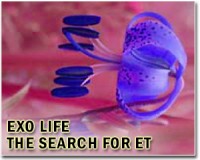 |
Hilo HI (SPX) Aug 02, 2010 How did life on Earth begin? One hypothesis is that terrestrial life began when organics were delivered from outer space during the early, heavy bombardment phase of Earth's development. We know that several meteorites (e.g., Murchison) have amino acids with properties similar to those seen in biological amino acids, the building blocks of life. An international team of astronomers led by Fukue and Tamura of the National Astronomical Observatory of Japan conducted research on the properties of light in a massive star-forming region (BN/KL nebula) of the Orion Nebula and have investigated a process that may have played a role in the development of life on Earth. The origin of what is technically called "biomolecular homochirality" is a longstanding mystery and an important one to solve, since it characterizes most life forms on Earth. Chirality refers to the handedness of an image or phenomenon, which is not identical to the mirror image of its counterpart, much as the right and left hands are similar in structure but are opposites and thus not the same. Homochirality means that a group of molecules exhibit the same handedness. Therefore, biomolecular homochirality indicates an organic group of molecules that are characterized by the same handedness. Terrestrial living material displays homochirality and consists almost exclusively of one enantiomer, L-amino acid, one of a pair of amino acids. What is intriguing is that amino acids in several meteorites show enantiomeric excesses of the same handedness as that seen in biological amino acids. Therefore, the process that produced the handedness of amino acids in the meteorites may provide clues to how homochirality developed in life forms on Earth. The larger question becomes how enantiomeric excesses can be produced and under what conditions. Addressing this question became the context within which the research team worked as they made observations of the Orion Nebula, one of the brightest and closest regions of high and low mass star formation near Earth. Since enantiomeric excesses can be produced by circularly polarized light, the research team focused on observing the degree of circular polarization in the star-forming region of the Orion Nebula. They developed the circular polarimeter for SIRPOL on SIRIUS, which is a wide-field near-infrared camera that works at three near-infrared bands (J-, H-, Ks-bands) simultaneously (http://seeds.mtk.nao.ac.jp/~kandori/SIRPOL-e.html). They used SIRPOL to measure the polarity with SIRIUS on the IRSF (Infrared Survey Facility) 1.4 m telescope in South Africa. Their results include the presentation of a wide-field and deep near-infrared (Ks band: 2.14 micron) circular polarization image of the Orion Nebula (Fig. 2), where massive stars and many low-mass stars are forming. This image reveals a circularly polarized region that is spatially extended around the BN/KL nebula, a massive star-forming region. The circular polarization here is high and significant, extending over a region about 400 times the size of the Solar System, an area observed that is much larger than that of previous studies. Other regions contrast with this one and show no significant circular polarization. Unlike the BN/KL nebula, most of the low-mass young stars do not demonstrate a detectable extended structure in either linear or circular polarization. The researchers infer that their results indicate a process that could have played a role in the development of biological homochirality on Earth. They reasoned that if our Solar System formed in a massive star-forming region like Orion's, then circularly polarized radiation could have induced enantiomeric excesses in the parent bodies of meteorites and subsequently delivered to Earth.
Share This Article With Planet Earth
Related Links Subaru Telescope Life Beyond Earth Lands Beyond Beyond - extra solar planets - news and science
 More than water key in other Earths search
More than water key in other Earths searchPotsdam, Germany (UPI) Jul 26, 2010 The hunt for Earth-like planets in the universe, which usually looks for where water might exist, should consider photosynthesis instead, German scientists say. Researchers at the Potsdam Institute for Climate Impact Research argue while primitive life can exist without photosynthesis, it would be necessary for more complex multicellular organisms to emerge, Astrobiology Magazine report ... read more |
|
| The content herein, unless otherwise known to be public domain, are Copyright 1995-2010 - SpaceDaily. AFP and UPI Wire Stories are copyright Agence France-Presse and United Press International. ESA Portal Reports are copyright European Space Agency. All NASA sourced material is public domain. Additional copyrights may apply in whole or part to other bona fide parties. Advertising does not imply endorsement,agreement or approval of any opinions, statements or information provided by SpaceDaily on any Web page published or hosted by SpaceDaily. Privacy Statement |